 |
||
|
||
| ||
Iwill is just a calm and peaceful worker on the computer market. At the same time, the company has its own niche - its boards, as a rule, have everything necessary onboard: PCI Sound, IDE RAID, SCSI-adapter. But the boards reviewed today are ordinary. Only the BD133 has an integrated audio chip CMedia CMI8738. The KD266 is interesting with its chipset. Iwill is traditionally among the first makers of boards on new chipsets from ALi. And this time the company released a new board on the ALi M1649 right after the chipset had been announced. So, what about the chipset? ALi M1649 chipset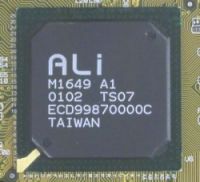
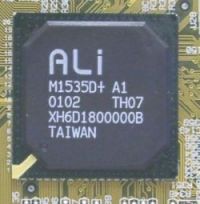
As you can see, the new chipset differs from the old one ALi MAGiK 1 (M1647 Northbridge) only in support of PC1600/PC2100 DDR SDRAM. It seems that they are almost identical: the NB M1649 is the same M1647 just without a DDR SDRAM controller. And now we have got VIA Apollo KT133A. It's really almost a complete analog (but for hardware monitoring integrated in the south bridge). It means that the ALi chipset will be positioned the same way as chipsets from VIA, only at a lower price. Iwill BD133 Board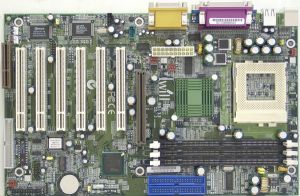
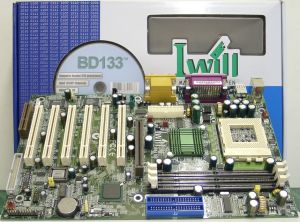 Apart from the board, the box contains a user's manual in English, ATA66/100 and FDD cables, a CD with drivers and different programs. Besides, a USB raiser, a thermo sensor, IRDA and SPDIF modules ship optionally. The CD contains not a rich set of software: Adobe Acrobat Reader, Antivirus PC-Cillin 2000 from Trend Micro and utilities for monitoring temperatures and fan speeds for different Iwill boards. Besides, there are descriptions of some other boards in .pdf format. The disc is bootable, i.e. after booting with this disc you can make diskettes with drivers for the board. The quality of implementation of the components is rather good. There are some drawbacks in the layout, though - the FDD connector is located behind the last PCI slot (it is inconvenient and prevents good air circulation). The CD-in and AUX-in connectors are located in front of PCI and AGP slots, and cards inserted into these slots may prevent a convenient work with these connectors. If the board is to be installed in a low case, the power supply connector can be difficult to reach as well, since it's located between an AGP slot and a socket. The circuit of the processor's core contains 9 1500uF capacitors. Although it's not impressing, they are enough for making the board work stably when the processor works at the rated frequencies. The board has several jumpers, for example, to enable/disable audio controller, clear the CMOS contents, protect the Flash chip from recording. You can also set the rated frequency of the processor (66, 100 and 133 MHz) and change the core voltage. All other settings can be made in the BIOS Setup. For example, you can choose a communication language for the "Voice Alert" technology which informs about the problems occurring during a start-up of the system (but the choice is limited by English and Chinese languages). Another proprietary technology, "Microstepping", allows you adjust the frequency of voltage of the processor. They can be changed from 66 to 200MHz in 1 MHz steps and from 1.6 to 2.05V in 0.05V steps, respectively. Besides, you can manually distribute interrupts among PCI slots. Memory settings are quite a lot. The board is not extraordinary as compared with other i815EP based boards, but at the same time I'm sure it will find its place on the market. Test systemTest equipment:
Software:
Performance of Iwill BD133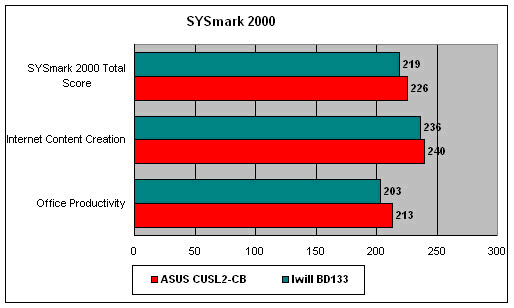  The results of the SYSmark 2000 and Quake III show quite well what the board is capable of. On the whole, the performance of the Iwill BD133 is not striking: it's a normal average board. The system worked stably, without any failures. That is why it can be recommended for those who are satisfied with 2-3 fps in the Quake III. Iwill KD266 Board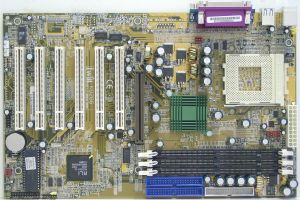
 Iwill is always first to get chipsets from Acer Labs Inc. (ALi) because the companies are old partners. In general, the Iwill KD266 board is remarkable exactly due to its chipset - in all other respects it is an ordinary product. Apart from the board, the box contains a user's manual in English, an 80-conductor ATA66/100 cable and an FDD one. Besides, a bracket with two additional USB ports for the rear panel of the computer, a thermo sensor and a cable with an IRDA module ship optionally with the board. There is also a Power Installer CD. The disc is bootable, therefore, you can create diskettes with drivers for different Iwill boards. Such approach is rational - for example, if a board has an IDE RAID controller, diskettes are necessary before the system starts booting, and in such cases manufacturers supply the diskettes with the required drivers. But in our case it isn't necessary to deal with such unreliable storage medium as a diskette. The disc contains drivers for different boards, descriptions for them in PDF format, files with their images, and software for reading of .pdf files - Adobe Acrobat Reader, Antivirus Trend Micro PC-Cillin 2000 and utilities for monitoring status of a board for different Iwill mainboards. The quality of implementation of the board is, as a rule, high. The configuration is one of the most popular for today: - 1 AGP and 6 PCI slots. The board has unsoldered space for an audio controller and audio connectors. It seems that it will be a chip from C-Media. The layout is convenient; there is only one tiny drawback - DIMMs are located too close to the AGP slot, and if a video card is inserted into it, memory modules will be difficult to install. The processor circuit contains 10 2200uF capacitors, which provide a stable operation of the system even if the conditions exceed the rated ones. The board has three jumpers: to clear the CMOS contents, to enable Keyboard Wake-Up and to change memory voltage - it can be lifted by 5 or 10%. Other settings are to be made in the BIOS Setup. The BIOS is based on the 6.00 version from Award. Here you can widely change memory settings, AGP ones and tune the processor. The Microstepping technology will help you change the FSB frequency from 100 to 180 MHz in 1 MHz steps, and the core voltage from 1.125 to 1.85V in 0.025V increments. Besides, you can change the frequency of the PCI bus - 1/3 or 1/4 of the FSB frequency. The only drawback is lack of possibility to change interrupts for PCI slots manually. Test systemTest equipment:
Software:
Performance of Iwill KD266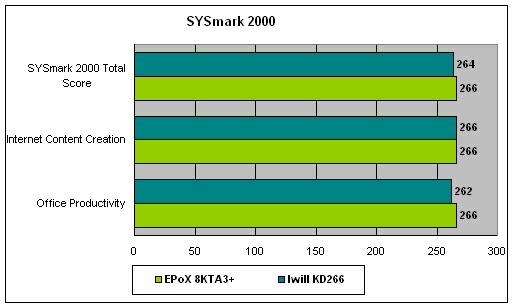 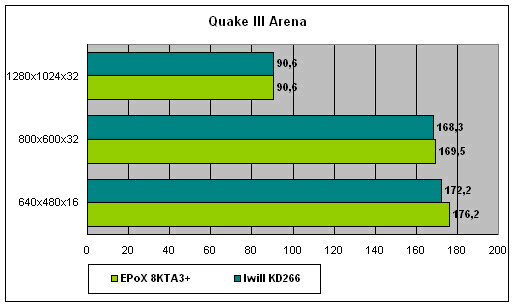 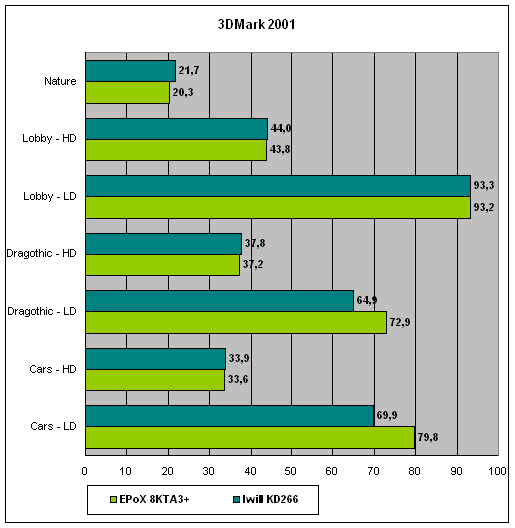 In this case we extended the set of tests and included 3DMark 2001, because quality of realization of GART drivers sometimes affects differently 3D games which use different APIs. But nothing new was discovered. The new chipset couldn't outscore the VIA Apollo KT133A, like the ALi MAGiK 1. But the ALi's board falls behind the competitor only in several tests of the 3DMark 2001, while in the Quake III both boards go on a par. So, on the whole the board is an ordinary well-implemented solution. The chipset shows average results as well. The majority of users won't notice a difference between it and a faster KT133A. ConclusionIwill has developed two stable boards with a good design and decent performance. The BD133 can attract a user with its integrated PCI sound on the CMedia chip. The KD266, despite an exotic chipset, works well and and flawlessly. But it seems that the ALi M1649 chipset is weaker in speed than the VIA Apollo KT133A, but not much. Provided that the price for the boards on this chipset is lower than for identical boards on the KT133A, the price/performance ratio can be considered very good. Highs:
Lows:
Write a comment below. No registration needed!
|
Platform · Video · Multimedia · Mobile · Other || About us & Privacy policy · Twitter · Facebook Copyright © Byrds Research & Publishing, Ltd., 1997–2011. All rights reserved. |